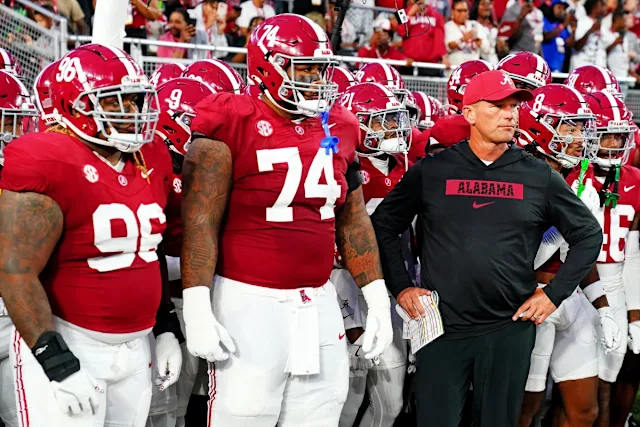
In the post-spring college football rankings, Alabama breaks into the top ten.
In the realm of college football, the post-spring rankings often serve as a way to gauge where teams stand after their spring practices. These rankings are far from final; they’re fluid, reflective of roster changes, coaching decisions, and spring performances that may not translate immediately to the regular season. However, these rankings hold significant weight as fans, players, coaches, and analysts alike scrutinize every movement in anticipation of the upcoming season. This year, the Alabama Crimson Tide has made a noteworthy appearance, breaking back into the top ten in the post-spring college football rankings after a challenging 2023 season.
For many, Alabama’s return to the top ten might seem inevitable, considering the powerhouse status they have held in college football for much of the 21st century. Under head coach Nick Saban, the Crimson Tide has built a dynasty, with national championships and SEC titles defining its modern era. Yet, 2023 was a year that tested the limits of Alabama’s dominance, with an offense that seemed to lack its usual spark and a defense that faced unexpected challenges. Still, the team managed to finish strong, and their ability to regroup and adjust during the offseason has put them in a favorable position heading into the 2024 season.
What makes Alabama’s rise in the post-spring rankings so compelling is not simply the historical prestige of the program but the specific challenges and successes that have defined their path to this point. The 2023 season was one in which Alabama’s offense, once the hallmark of its superiority, took a step back. Quarterback play, which had been consistently excellent under Saban, was a major talking point. Jalen Milroe, who took the reins as the starting quarterback, showed flashes of brilliance, but also had moments of inconsistency that led to some frustrating performances. Alabama’s offense, traditionally a juggernaut, struggled to find its rhythm, leading to some doubts about whether the Tide could reclaim their place at the top of the college football world.
Despite these struggles, Alabama’s defense remained among the nation’s elite, anchored by a unit that featured a host of future NFL talent. The defensive line was particularly strong, with standout players like Dallas Turner and Jaheim Oatis providing constant pressure on opposing quarterbacks. In the secondary, Kool-Aid McKinstry emerged as one of the top cornerbacks in college football, and safety Malachi Moore was a key playmaker in the back end. These defensive leaders gave Alabama a reliable foundation, one that helped the team stay competitive even when the offense was not firing on all cylinders.
In addition to the returning talent, the Crimson Tide saw significant changes in their coaching staff that generated intrigue heading into the offseason. Saban made a bold move to adjust the offensive coaching staff, bringing in new blood to rejuvenate a unit that had underperformed. Alabama’s offensive coordinator, Tommy Rees, arrived from Notre Dame with a reputation for molding quarterbacks and building balanced offenses. Rees was expected to help bring more consistency to the quarterback position and provide a more dynamic scheme that could unlock Alabama’s full potential. Additionally, the Tide’s recruiting efforts had continued to be among the best in the nation, with a class full of highly touted players joining the program. This influx of talent, combined with the coaching adjustments, gave Alabama fans plenty of optimism heading into the 2024 season.
One of the most significant takeaways from the post-spring rankings is that Alabama’s resurgence is not just about the players they are returning, but the impact of their offseason work. The team’s spring practices were a crucial time for evaluating personnel and working on team chemistry. Nick Saban, a master of maximizing potential and adjusting to the changing landscape of college football, took full advantage of this period to retool and refine the squad. The quarterback position, in particular, remained a focal point, with Milroe looking to solidify his hold on the starting role while facing competition from other talented signal-callers in the program. Milroe’s athleticism and raw talent were on display during the spring, and the expectation is that he will continue to develop into a more polished and consistent leader for the offense.
Alabama’s offensive line was another area of concern in 2023, as the unit had been inconsistent in both pass protection and run blocking. However, during spring practices, there was a noticeable improvement in the cohesion of the line, and several young players emerged as potential starters. The return of key veterans, combined with the influx of young talent, means that the offensive line could be one of the stronger units for Alabama in 2024. This would be a critical development for the Crimson Tide, as a dominant offensive line is essential for any successful championship run.
The receiving corps is another area where Alabama showed promise in the spring. Although the team lost some key playmakers to the NFL, there was no shortage of talent in the wide receiver room. Players like Jermaine Burton, Isaiah Bond, and Ja’Corey Brooks stepped up during the spring, showcasing their ability to make big plays and stretch the field. With Milroe’s ability to create plays with his legs, the wide receivers could be the beneficiaries of more opportunities to make explosive plays in the 2024 season.
Alabama’s running back situation also garnered attention during the spring. With the departure of star running back Jahmyr Gibbs, there were questions about who would step up to take over the lead role. However, the Crimson Tide had multiple viable options, including returning backs Jase McClellan and Roydell Williams, as well as talented freshmen like Justice Haynes. The running back group was one of the deeper units on the roster, and its ability to provide a consistent ground game would be essential to the offense’s success.
Looking ahead, Alabama’s place in the post-spring rankings serves as a reflection of the potential for growth that the program possesses. The talent is undeniable, and the combination of returning players, new coaching strategies, and a deep recruiting class has put the Crimson Tide back in the conversation for national championship contention. While Alabama’s 2023 campaign may have fallen short of expectations in some areas, the team is well-positioned to bounce back and once again establish itself as a force to be reckoned with in college football.
Breaking into the top ten in the post-spring rankings is a signal that Alabama is on the right track. It shows that the Crimson Tide is not only adapting to the challenges of modern college football but thriving in the face of them. This is a program that has weathered plenty of storms over the years and has consistently found a way to return to prominence. The work done in the spring, from refining the quarterback position to building depth in the trenches, sets the stage for a potentially successful 2024 season.
The road to a national championship, however, is never easy, and Alabama will face stiff competition in the SEC and beyond. The conference remains one of the most competitive in college football, with teams like Georgia, LSU, and Tennessee all poised to challenge Alabama for supremacy. Additionally, teams from other conferences, such as Michigan, Ohio State, and USC, will also be in the mix for a playoff spot. The strength of Alabama’s schedule, which features perennial powerhouses like Texas and SEC rivals, will provide the team with numerous opportunities to prove itself. The key for Alabama will be maintaining consistency and continuing to improve over the course of the season, especially in the areas where they struggled in 2023.
Despite the challenges ahead, the Crimson Tide’s appearance in the post-spring top ten demonstrates that they are still one of the most dangerous teams in college football. With a seasoned coaching staff, a wealth of talent on both sides of the ball, and the desire to prove themselves after a less-than-ideal 2023 season, Alabama is poised to make a significant impact in the 2024 season. For Alabama fans, this return to the top ten is a reminder that their team is never far from greatness, and that the road to a championship runs through Tuscaloosa once again. The stage is set for Alabama to make a statement in 2024, and the post-spring rankings are just the beginning.





